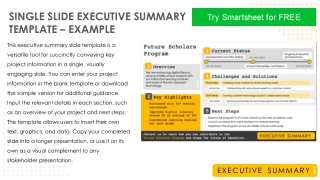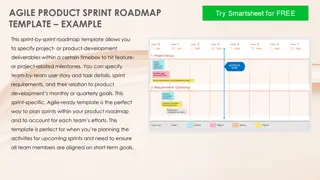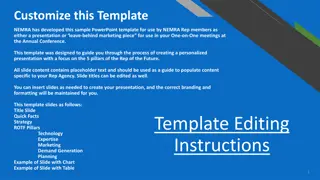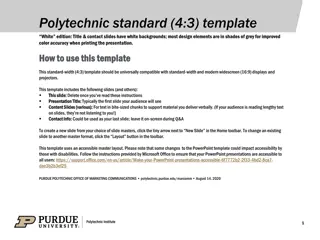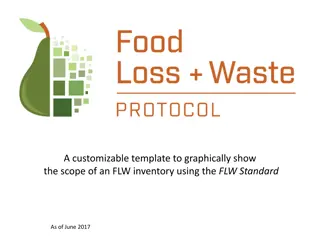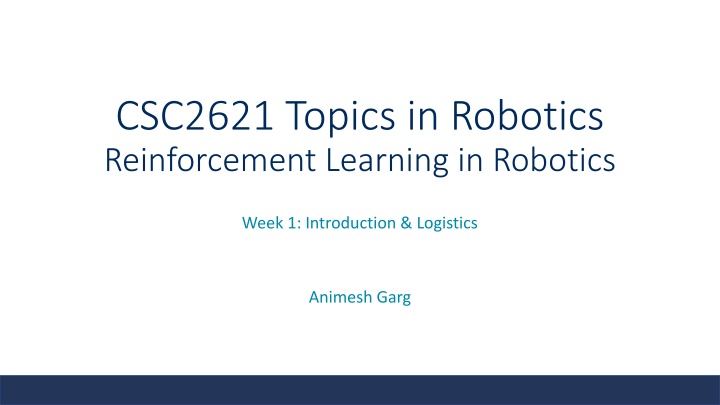
Reinforcement Learning in Robotics: Week 1 Introduction & Logistics
Explore the introductory topics in robotics and reinforcement learning, featuring insights from Animesh Garg. Delve into the importance and complexity of the problems being solved, along with key contributions and background information necessary to understand the proposed work. Discover the approach, algorithms, experimental results, and discussions that shed light on advancements in this field.
Download Presentation

Please find below an Image/Link to download the presentation.
The content on the website is provided AS IS for your information and personal use only. It may not be sold, licensed, or shared on other websites without obtaining consent from the author. If you encounter any issues during the download, it is possible that the publisher has removed the file from their server.
You are allowed to download the files provided on this website for personal or commercial use, subject to the condition that they are used lawfully. All files are the property of their respective owners.
The content on the website is provided AS IS for your information and personal use only. It may not be sold, licensed, or shared on other websites without obtaining consent from the author.
E N D
Presentation Transcript
CSC2621 Topics in Robotics Reinforcement Learning in Robotics Week 1: Introduction & Logistics Animesh Garg
Human Learning in Atari* Tsivdis, Pouncy, Xu, Tenenbaum, Gershman Topic: Human Learning & RL Presenter: Animesh Garg with thanks to Sam Gershman sharing slides from RLDM 2017 *This presentation also serves as a worked example of type of expected presentation
Motivation and Main Problem 1-4 slides Should capture - High level description of problem being solved (can use videos, images, etc) - Why is that problem important? - Why is that problem hard? - High level idea of why prior work didn t already solve this (Short description, later will go into details)
Contributions Approximately one bullet, high level, for each of the following (the paper on 1 slide). - Problem the reading is discussing - Why is it important and hard - What is the key limitation of prior work - What is the key insight(s) (try to do in 1-3) of the proposed work - What did they demonstrate by this insight? (tighter theoretical bounds, state of the art performance on X, etc)
General Background 1 or more slides The background someone needs to understand this paper That wasn t just covered in the chapter/survey reading presented earlier in class during same lecture (if there was such a presentation)
Approach / Algorithm / Methods (if relevant) Likely >1 slide Describe algorithm or framework (pseudocode and flowcharts can help) What is it trying to optimize? Implementation details should be left out here, but may be discussed later if its relevant for limitations / experiments
Experimental Results >=1 slide State results Show figures / tables / plots
Discussion of results >=1 slide What conclusions are drawn from the results? Are the stated conclusions fully supported by the results and references? If so, why? (Recap the relevant supporting evidences from the given results + refs)
Critique / Limitations / Open Issues 1 or more slides: What are the key limitations of the proposed approach / ideas? (e.g. does it require strong assumptions that are unlikely to be practical? Computationally expensive? Require a lot of data? Find only local optima? ) - If follow up work has addressed some of these limitations, include pointers to that. But don t limit your discussion only to the problems / limitations that have already been addressed.
Contributions (Recap) Approximately one bullet for each of the following (the paper on 1 slide) - Problem the reading is discussing - Why is it important and hard - What is the key limitation of prior work - What is the key insight(s) (try to do in 1-3) of the proposed work - What did they demonstrate by this insight? (tighter theoretical bounds, state of the art performance on X, etc)


